
Astrophytum myriostigma, the bishop's cap cactus, bishop's hat or bishop's miter cactus, is a species of cactus native to the highlands of northeastern and central Mexico.

Opuntia microdasys is a species of flowering plant in the cactus family Cactaceae, native and endemic to central and northern Mexico.
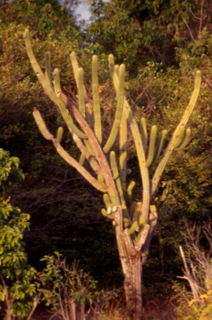
Pilosocereus is a genus of cactus native to the Neotropics. Tree cactus is a common name for Pilosocereus species.

Echinocactus grusonii or Kroenleinia grusonii, popularly known as the golden barrel cactus, golden ball or mother-in-law's cushion, is a species of barrel cactus which is endemic to east-central Mexico.

Astrophytum ornatum, the bishop's cap or monk's hood cactus, is a flowering plant of the family Cactaceae, endemic to the Central Plateau of Mexico. It is the largest and tallest species of Astrophytum.

Echinocereus reichenbachii is a perennial plant and shrub in the cactus family. The species is native to the Chihuahuan Desert and parts of northern Mexico and the southern United States, where they grow at elevations up to 1,500 meters (4,900 ft). This cactus earned the Royal Horticultural Society's Award of Garden Merit.

Ferocactus glaucescens, the glaucous barrel cactus, is a species of flowering plant in the family Cactaceae, native to the limestone hills of Hidalgo, endemic to México. It is a spherical or cylindrical cactus growing to 60 cm (24 in) in diameter, with long yellow spines and yellow flowers in summer.

Ferocactus viridescens is a species of flowering plant in the cactus family Cactaceae. This rare barrel cactus is known by several common names, including coast barrel cactus, keg cactus and San Diego barrel cactus. Most of its native range in the United States is in San Diego County, California, where it is threatened by development, agriculture, and other alterations in its habitat. It is also found in northern Baja California, Mexico.

Pilosocereus royenii is a species of cactus found throughout the West Indies and the states of Yucatán and Quintana Roo in Mexico. Common names include Royen's tree cactus, dildo cactus, and pipe organ cactus. It is composed of multiple long, tubular shaped branches, each ribbed with multiple sections and sharp spines.

Mammillaria spinosissima, also known as the spiny pincushion cactus, is a species of flowering plant in the cactus family Cactaceae, endemic to the central Mexican states of Guerrero and Morelos, where they grow at elevations of approximately 1,600 to 1,900 metres. The species was described in 1838 by James Forbes, gardener of the Duke of Bedford. Botanist David Hunt collected a specimen in 1971, when he located one near Sierra de Tepoztlan, Mexico.

Mammillaria carmenae, the Isla Carmen pincushion cactus, is a species of flowering plant in the family Cactaceae.

Mammillaria geminispina, the twin spined cactus, is a species of flowering plant in the family Cactaceae, native to central Mexico. It grows to 25 cm (10 in) tall by 50 cm (20 in) broad. The clustering spherical stems, 8 cm in diameter, are covered in white down and white spines. Carmine pink flowers are borne in summer and autumn.
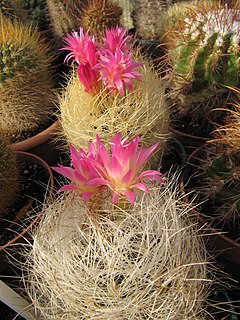
Eriosyce senilis, called old-man cactus along with a number of similar species, is a species of cactus in the genus Eriosyce, native to Chile. It has gained the Royal Horticultural Society's Award of Garden Merit.
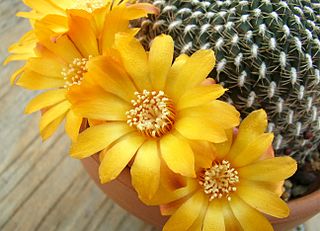
Rebutia arenacea, the arenaceous crown cactus, is a species of cactus in the genus Rebutia, native to central Bolivia. It has gained the Royal Horticultural Society's Award of Garden Merit.
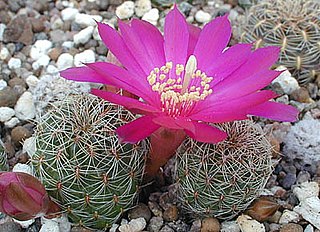
Rebutia canigueralii is a species of cactus in the genus Rebutia, native to Bolivia. It has gained the Royal Horticultural Society's Award of Garden Merit.

Rebutia mentosa, the crown cactus, is a species of cactus in the genus Rebutia, native to Bolivia. It has gained the Royal Horticultural Society's Award of Garden Merit.

Rebutia neocumingii, the Cuming crown cactus, is a species of cactus in the genus Rebutia, native to Bolivia and Peru. It has gained the Royal Horticultural Society's Award of Garden Merit.
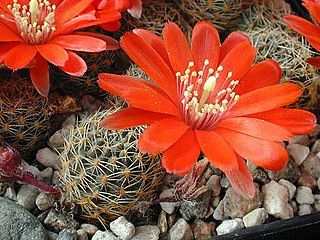
Rebutia pygmaea is a species of cactus in the genus Rebutia, native to Bolivia and northwest Argentina. It has gained the Royal Horticultural Society's Award of Garden Merit.

Rebutia steinbachii, called Steinbach's crown cactus, is a species of cactus in the genus Rebutia, native to Bolivia. It has gained the Royal Horticultural Society's Award of Garden Merit.

Disocactus speciosus, the sun cactus, is a species of flowering plant in the family Cactaceae. It is native to Mexico, Honduras and Guatemala, and has been introduced to the Canary Islands. As its synonym Heliocereus speciosus it has gained the Royal Horticultural Society's Award of Garden Merit.




















